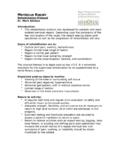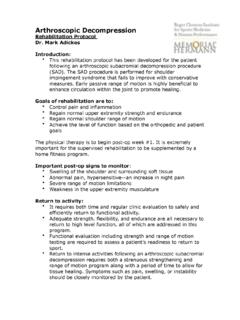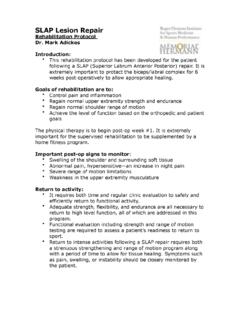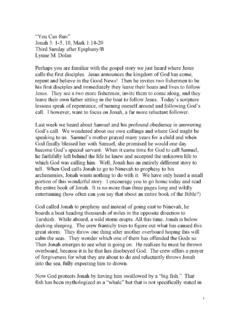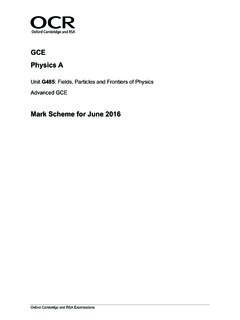Transcription of Mark Adickes, M.D.
1 Mark Adickes, Orthopedics and Sports Medicine 7200 Cambridge St. #10A Houston, Texas 77030 Phone: 713-986-6016 Fax: 713-986-5411 TRICEPS TENDON REPAIR PROTOCOL This rehabilitation protocol has been developed for the patient following a tenodesis (reattachment) of the long head of the biceps tendon surgery. This protocol will vary in length and aggressiveness depending on factors such as: Quality of the repaired biceps tendon tissue Presence of additional procedures such as shoulder arthroscopy Degree of shoulder instability or weakness or deconditioning prior to surgery Acute versus chronic condition Length of time immobilized Strength/pain/swelling/range of motion status Rehabilitation goals and expectations Early passive range of motion is highly beneficial to enhance circulation within the joint to promote healing.
2 The protocol is divided into phases. Each phase is adaptable based on the individual and special circumstances. The overall goals of the surgical procedure and rehabilitation are to: Control pain, inflammation, and swelling Regain normal upper extremity strength and endurance Regain normal shoulder range of motion Achieve the level of function based on the orthopedic and patient goals Physical therapy should be initiated after the first week post-op. The supervised rehabilitation program is to be supplemented by a home fitness program where the patient performs the given exercises at home or at a gym facility.
3 Important post-op signs to monitor: Swelling of the arm or shoulder and surrounding soft tissue Abnormal pain response, hypersensitivity, increasing night pain Severe range of motion limitations Weakness in the upper extremity musculature Improper mechanics or scapular dyskinesia Core and peri-scapular strength deficits Return to activity requires both time and clinical evaluation. To safely and most efficiently return to normal or high level functional activity, the patient requires adequate strength, flexibility, and endurance.
4 Functional evaluation including strength and range of motion testing is one method of evaluating a patient s readiness return to activity. Return to intense activities following a biceps tenodesis requires both a period of time to allow for tissue healing along with a graduated strengthening and range of motion program. Symptoms such as pain or swelling should be closely monitored by the patient and therapist. Specific exercises may be added, substituted, or modified where clinically appropriate by experienced sports/shoulder therapists or trainers who have expertise in the care of post-operative tendon repair procedures.
5 While patients may be "cleared" to resume full activities at 6+ months following surgery, additional time spent in full activity or sport participation is often necessary to achieve maximal recovery. TRICEPS TENDON REPAIR PHASE 1: WEEK 1-2 PRECAUTIONS Elbow immobilized in posterior splint at 60 elbow flexion for 1st 2 weeks No active elbow extension 6 weeks ROM Gradual Active/Passive ROM of shoulder in all planes while in splint Wrist/hand/finger full AROM in splint STRENGTH Scapular retractions Shoulder shrugs MODALITIES Hot pack before treatment E-stim.
6 TENS as needed Ice 10-15 minutes after treatment GOALS OF PHASE 1 Control pain and inflammation Protect repair Independent in HEP PHASE 2: WEEK 3-6 PRECAUTIONS Elbow placed in a hinged ROM brace allowing 30 -60 Brace to be worn at all times except during exercise or bathing Passive ROM ONLY for elbow extension ROM Hinged Brace Range of Motion Progression (ROM progression may be adjusted base on Surgeon s assessment of the surgical repair.) o Week 2-3: 30 -60 o Week 4-5: 15 -90 o Week 6-7: 10 -110 o Week 8: 0 -125 Forearm: Initiate AAROM pronation and supination Progress to active pronation and supination (wk 4) Shoulder AROM as needed in brace STRENGTH (in brace) Isometric shoulder exercises Supine/standing rhythmic stabilizations Wrist/hand.
7 Grip strengthening Standing flexion and scaption Side-lying ER Isometric biceps pain free (week 6) MANUAL Scar mobilization Passive elbow extension Joint mobs as needed MODALITIES Heat/hot pack before therapy US to incision as needed Ice 10-15 minutes GOALS OF PHASE 2 Protection of repair Gradual increase in ROM Initiate strengthening to surrounding tissues Improve scapular stability PHASE 3: WEEK 7-12 ROM Week 8 progress to full ROM of elbow; discontinue brace if adequate motor control Initiate UBE light resistance Exercises o Ball roll outs on table o Wall walk o Pulley STRENGTH Tricep/elbow extension progression o 6 weeks: initiate AROM o 8 weeks: initiate light theraband resistance Theraband IR/ER shoulder Theraband bicep extension Prone dumbbell therex Rhythmic stabilization MANUAL Passive elbow extension if lacking Joint mobs as needed to regain full flexion Week 10.
8 Passive or contract relax to gain full flexion if still lacking MODALITIES Ice 10-15 minutes GOALS OF PHASE 3 Reach full ROM Initiate loading to repair Enhance neuromuscular control Pain free ADLs PHASE 4: WEEK 12+ STRENGTH: Progress strengthening program with increase in resistance and high speed repetition Bicep curls with dumbbells Initiate IR/ER exercises at 90 abduction Progress rhythmic stabilization activities to include standing PNF patterns with tubing Initiate plyotoss double arm progress to single arm Initiate sport specific drills and functional activities Initiate interval throwing program week 16-20 Initiate light upper body plyometric program week 16-20 Progress isokinetics
9 To 90 abduction at high speeds MODALITIES Ice 15-20 minutes GOALS OF PHASE 4 Full painless ROM Maximize upper extremity strength and endurance Maximize neuromuscular control Optimize shoulder mechanics/kinematics Optimize core stability Initiate sports specific training/functional training


